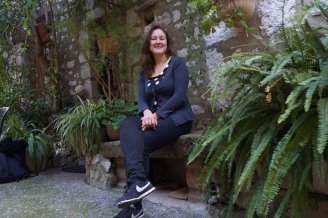Copyright 2012 neutronsources.org | All rights reserved. | Powered by FRM II | Imprint / Privacy Policy
Diana Lucia Quintero Castro
Associate Professor, University of Stavanger, Norway

Can you tell us about your studies and your scientific field?
I studied physics engineering, it was followed by a master in physics and in 2011 I received my PhD from the Technical University of Berlin on Neutron scattering methods for the investigation of magnetic materials. I am very interested on the physics behind highly frustrated magnetic systems. These systems can have very unusual ground states with enhanced quantum fluctuations, taking a big distance to the magnetic materials which are commonly use in technological applications so far. It is necessary to develop new theories which can explain the behavior of these unusual systems but for that a complete characterization of the structures and dynamics has to be done. My research area is to prepare this class of materials, perform neutron and X-ray diffraction to understand the nuclear and magnetic structure and finally measure and model the magnetic excitations.
What´s your Neutron-scattering background?
During my PhD I learnt to use neutron scattering techniques to investigate magnetic materials. I enjoyed a lot the experiments and was very interested on the technical aspects of the techniques. Therefore, I looked for postdoctoral positions related to neutron instrumentation. From 2011 until 2016 I was instrument responsible for the cold neutron triple axis spectrometer FLEXX, at BERII, HZB. During this period I was involved in the commissioning phase of the spectrometer, as well as on the development and implementation of new instrumental methods. FLEXX offers experimental conditions which are not found in other cold triple axis neutron spectrometer at another neutron sources (neutron resonance spin echo, multianalysers, high magnetic fields). I had the possibility to guide international neutron users while they performed unique experiments and my job was to make sure the instrument was running always well and that all the experimental conditions were satisfied to obtained high quality data. As for my research, I use different neutron instruments at ISIS, ILL, PSI, NIST and HZB.
Can you describe step by step how you got to your position?
I studied physics engineering at the National University of Colombia. My scientific interests were much closer to fundamental physics questions than to technological related goals. This is why I did my Master degree on Physics at the University of Antioquia also in Colombia.
Since my bachelor thesis, I have been investigating magnetic materials and I was specifically looking for a PhD in neutron scattering in magnetic materials. Back in Colombia, I got to know about the Hahn Meitner Institute (now Helmholtz Zentrum Berlin) and what they could do by using neutron techniques. I applied from Colombia to a PhD position with Bella Lake. At the same time I had the opportunity to come to Europe for a school on neutron scattering organized by ICTP in Trieste and could meet her in person. She later took me as her student. After I completed my PhD I was instrument responsible for about five years. Then I felt the need to teach what I have learnt and started applying for positions at Universities. I got a position as Associate professor at the University of Stavanger in Norway and I moved over here at the beginning of 2017.
Would you like to list some of your publications for us?
Some of my publications related to my research in magnetism are:- Zhe Wang, D. L. Quintero‐Castro, et al., Phys. Rev. Lett. 116 (14 Apr. 2016)
- J. Jensen, D. L. Quintero‐Castro, et al., Phys. Rev. B 89.13 (2014)
- D. L. Quintero‐Castro, B. Lake, et al., Phys. Rev. Lett. 109.12 (2012)
- D. L. Quintero‐Castro, B. Lake, et al., Phys. Rev. B 86.6 (2012)
- Rasmus Toft‐Petersen, Felix Groitl, Mathias Kure, Joshua Lim, Petr Cermak, Svyatoslav Alimov, Thomas Wilpert, Manh Duc Le, Diana Quintero‐Castro, et al., Nuc. Inst. & Methods Section A 830, 338–344 (2016)
- F. Groitl, T. Keller, D. L. Quintero‐Castro, K. Habicht, Rev. of Sci. Ins. 86.2 (2015)
- M. D. Le, D. L. Quintero‐Castro, et al., Nuc. Inst. & Methods Section A 729, 220–226 (2013)
What percentage of your time do you dedicate to your family/ work/ for you?
The time I dedicate to family/work/for me fluctuates over time and there is not a week similar to a previous one. It depends on approaching deadlines, experiments and trips. I try to have the time to do sports at least twice per week and to enjoy complete weekends.
Who or what is your mentor or greatest inspiration?
My PhD supervisor Bella Lake has been a mentor for me and an example to follow, as well as my former boss Klaus Habicht. I have learnt a lot from both of them. Also, I always look for advices from my friend and former colleague Elisa Wheeler, also a neutron scatterer, she always gives me new challenges to think about. As for my greatest inspiration, I would say is the beauty of nature and its symmetry –as cliché as it sounds :) .
What is the most challenging thing you have faced in your career?
Scientific career implies to live where chances exist, it is based in the free movement of individuals, and therefore in the need of migration. The biggest challenge for me is to be far away from my family. The distance is stealing us the opportunity to share our lives and forces me to prioritize career over family.
Contact details
Diana Lucia Quintero Castro
Associate Professor
Department of Mathematics and Natural Science
TN-Faculty
University of Stavanger
N-4036 Stavanger
NORWAY
Email: diana.l.quintero@uis.no